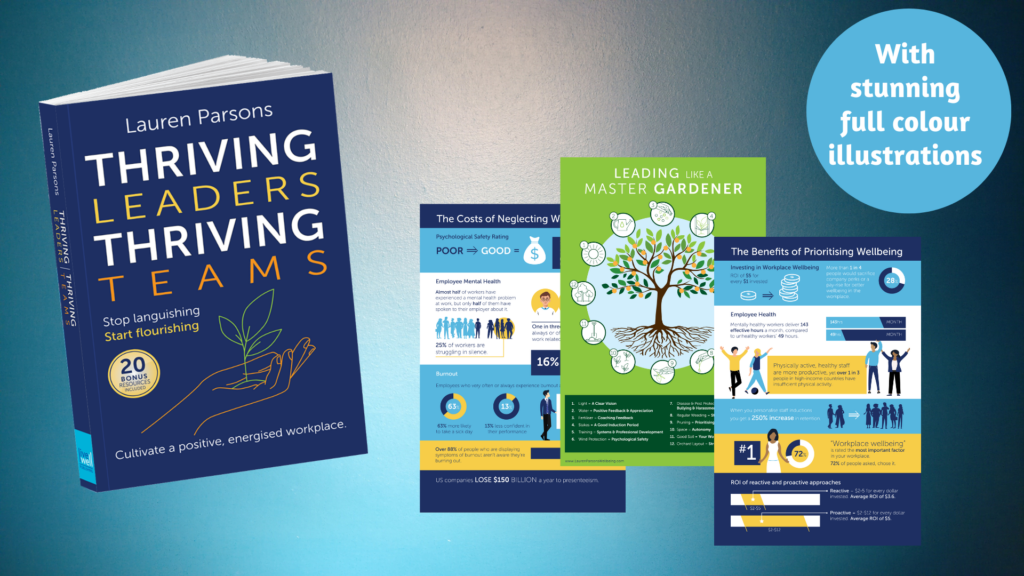An excerpt from Lauren Parsons book ‘Thriving Leaders Thriving Teams’.
“Returning from work feeling inspired, safe, fulfilled and grateful is a natural human right to which we are all entitled and not a modern luxury that only a few lucky ones are able to find.” – Simon Sinek
Stress is a part of life. Some stress is good for us. Without it, we’d be completely bored and apathetic. The right amount is invigorating. As long as we feel we can cope, stress motivates us to perform at our peak.
This is called eustress. Good stress. It gives us a sense of purpose and achievement. The key is to find the sweet spot in terms of the stress balancing act. Once our stress levels go past this point, however, we experience distress, which leaves us feeling overwhelmed.
The Stress Curve
Physiologically, the stress response impairs cognitive performance, impacting your ability to think straight. A stressed brain can’t fully function. This only adds to the stress, creating a negative spiral.
Some stressors come from the workplace, others come from outside work, and some are internal, related to our perception of pressure and our own expectations. Stress can have serious negative impacts on your staff’s personal wellbeing and huge costs for your organisation. It’s been shown to lower performance, increase accidents and speed up staff churn.
Most staff expect their organisation to protect their mental wellbeing at work. 83% of people believe their employer should manage work-related stress and conflict, to protect staff mental health. Only 13% feel it’s a joint responsibility and 4% say it’s up to employees.

Experienced orchardists know the value of shielding their trees from wind and protecting them from harmful pests. While you may not be able to control the stressors outside work, leaders can have a huge impact in either adding to, allowing or preventing workplace stress. You can also help staff understand and use tools and strategies to better manage and cope when they feel under pressure, and ensure support is available and easily accessible when it’s needed.
Managing Capacity
When my husband Morrie was deployed in Afghanistan, he lived at a base in the Hindu Kush mountains. The base was powered entirely by generators and as the base grew in size, more people meant more appliances to plug in. While the base was being prepared for winter, he and an electrician were discussing the size of generator required for the increased power consumption. The electrician outlined how critical it was that the generator’s capacity was well above the planned day-to-day operating requirements.
He gave an example that a new 500 KvA generator loaded to 100% of its capacity will at first generate 500 KvA of power. However, if continually loaded to full capacity, that generator’s potential output will degrade dramatically, meaning it will no longer be able to deliver what it was designed to. It’s like putting its working life on fast-forward.
Continuing to load a generator to 100% makes its maximum capacity (those 500 KvA) rapidly reduce over time. Very soon, it can only produce 400 KvA, and then 300 KvA and so on. Even when it’s ‘maxed out’, its new potential output is much lower.
Generators have a sweet spot of around 70% of their total capacity. Keeping them running at or around this point, maximises their potential output over their lifetime. The remaining 30% provides a buffer, allowing for spikes in load if more power is needed in any given moment. These short term increases aren’t harmful if they’re only brief in nature.

Load vs Capacity
When you think of your workforce, they too can work at 100% of their capacity at times. If however, you load them to 100% almost all the time, you’re likely to degrade their ability to perform. Even (and you could argue especially) your high-performers need to build buffers into the way they operate to prevent burnout.
Very few organisations effectively monitor, plan for and manage workload, capacity and performance. This is vital so your people can perform at their sweet spot.
Another analogy is to compare Formula One race cars to long-haul trucks. Race car engines, which get pushed to their maximum, need to be virtually rebuilt after each race. Long-haul truck engines however, which run in their optimum load zone (their sweet spot) may do a million kilometres before being rebuilt or replaced.
When long-haul truck drivers keep their vehicles in the optimum rev range they:
1. Maximise the engine life.
2. Optimise fuel usage.
3. Minimise wear and tear, reducing maintenance time required.
Are you running your team like race cars to see short term results, or like long-haul trucks to go the distance? What checks and balances do you have to help people manage load and capacity?
Enjoyed this article?
To find out more about Managing Your Capacity to Avoid Burnout, read the whole Thriving Leaders, Thriving Teams book. Order your copy today here.
Complete will full colour, full page illustrations, it’s a fantastic guide to help you stop languishing and start flourishing.

“An extraordinarily powerful book with an inspiring mission at its heart. If you want to cultivate and sustain the right conditions for your team and workplace culture to flourish, this book is your guide, your support and your inspiration”
– Steven Hargreaves, Author of The Compassionate Leader’s Playbook
“Thriving Leaders, Thriving Teams makes a compelling case for fostering wellbeing in the workplace and is full of practical tools and ideas for both individuals and leaders on how to do this.”
– Suzi McAlpine, Author of Beyond Burnout
A must-have for all leaders. Comprehensive, practical and easy to read!
– Karen Tui Boyes, CEO
Share this Post
